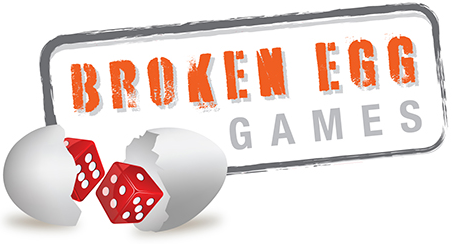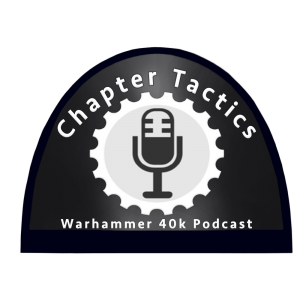Chapter Tactics is a 40k podcast which focuses on promoting better tactical play and situational awareness across all variations of the game. This is the first episode in a series of episodes which are going to break down each phase of the game, and dive into how you can master them. Today’s episode is going to cover list building techniques and thought processes to build a solid TAC list for competitive 40k events.

Show Notes:
- Our Sponsor the Iron Halo put out a promo video! Check it out!
- Don’t forget to check out our new sponsor! Broken Egg Games, and Rum Runner Wargame Painting and Conversions.
- Click here for a link for information on downloading best coast pairings app where you can find lists for most of the events I mention.
- Check out the last episode of Chapter Tactics here. Or, click here for a link to a full archive of all of my episodes.
- Commercial music by Music by: www.bensound.com
- Intro by: Justin Mahar


Need help with a list idea? Got a rules question? Want to talk tactics? Then email me at…
frontlinegamingpeteypab@gmail.com
Please do not send an army list in a format such as Army Builder, send them in an easy to read, typed format. Thanks!



Drown everything in bodies… TAC list solved.
Drown everything in bodies, you now have a TAC list, problem solved!
Have you tried drowning everything in bodies?
Just a thought
You know the comments can be bugged, but thanks for mimicking me, immitation is the sincerest form of flattery
The recording software is still being silly. Every 15 or so minutes a person repeats himself and than fast forwards.
Also Pablo is the master rambler: at 35:30 was very rambly. You really need to learn not to overelaborate or explain every little thing. Example:
Your point is: don’t take units with bad durability (that can be shot) in a list with a lot of good durability units or your opponent will just kill the bad durability unit instead. However you say: “I play imperium soup” – most listeners know that, especially 35 minutes in.
Then you say “I like herohammer too but” – what does that have to do with the point you’re trying to get across?
Then you go into “imperium has flexibility so I use them” – which goes back to the first things you say in the podcast – you build TAC lists.
The points you make aren’t bad. Just getting to them needs some work.
Finally, I basically do the same thing Steve does. Get a new codex, open excel sheet, find the best unit durability and damage wise (with range, mobility, morale in mind). This way I know not to bother with stuff like Kataphrons, Ruststalkers, Servitors, Fistellans, etc.
Also if you have a (for example) dedicated melee unit – compare them to similar units in the other armies. You might think “wow these Flayed Ones are great”, however when other armies have genestealers, orkboyz, tzangors and bloodletters – maybe your army isn’t going to be a melee centric army and you should just leave the Flayed Ones on the shelf.
Hey RVD where did this occur? I listened to most of the episode while editing and I never accounted that problem. That would really help me out.
On your points. At least i’m a master at something! I’ve heard this critique my entire life. I think I’ve improved quite a bit and in particular this Imperial soup example you’re bringing up actually had a purpose. A lot of people who listen to this podcast are listening to it the first time. So they don’t necessarily know I play imperial soup lists. The Herohammer was just to expand a little further as to the kinds of Imperial soup lists I run to give you all some context about the kind of player I am when it comes to list building.
The point of that was to say that I used scout bikers in my lists, but I fell into the pitfall of taking something because it’s “good” and not because it fit my style of list.
I agree I probably should have left this bit out, because I think it needed further expanding to be explained properly. Meh, while listening I also think I did the best job I could to push the conversation along. I also certainly stopped other PP ramblings.
Also, i’m glad that works for you too. I usually write a list and then update it with version numbers and small unit changes. Even if the initial product isn’t the most optimal. Which leads to some sub-optimal lists, but lists I also love to play.
@rvd1ofakind: Do you find that level of statistical analysis to be helpful? I feel like I might make some calculations if I’m interested in some generalities, but usually go with my “gut” to tell me whether a unit is good or not for the points.
I think it depends on a lot of other factors whether it’s meaningful. Some people are better than others at assessing the relative value of units in a particular role- so it might be obvious to you that, say, Heavy Weapons Teams are always more efficient than a Wyvern for indirect fire, but another player might not make that intuition. For those players, doing the math can be a good way to understand what is more efficient (and eventually develop those intuitions, potentially.)
On the other hand, there are a lot of outfalls of math that _aren’t_ obvious to much of anyone- this is especially true for more complex calculations (“Which is more resistant to Lasguns per point, an Armored Sentinel or Plaguebearers?”) and those that are relatively new to the game. At the start of 8E there were a lot of spreadsheets floating around on the relative efficiency of various guns because most of the old rules had been overturned and the relative value of different weapons had changed a lot. So in cases where there isn’t a precedent, it helps a lot to do the math.
With all of that said, though, math alone won’t tell you which units are good and which units aren’t; it takes a deeper understanding of the game than that. But it can certainly help inform your decisions, and completely disregarding mathhammer is often the sign of a bad player.
8th ed especially is guilty of making very similar units. For example: in 7th infiltrators and ruststalkers has a bunch of weird abilities and weapons. Now they’re just beatsticks. So now more than ever, mathhammer is important.
For example – you can compare Beasts of Nurgle to Plaguebearers. Sure – they might seem very different. But at the end of the day they are just durable beatsticks. However not only are plaguebearers better at offence and defence – they fill a troop role, can get a banner, are buffed by spoilpox, cover more board space.
The units in this game are and have always been priced very poorly. There are a TON of units (more than half) that are just statistical downgrades of other units AND they often cost more. Mathhammer helps to avoid those.
am I the only one whom checks the tenor of the comments before committing to listening to the episode in full?
PeteyPab, I often find myself making the “get on with the point” hand-motion when listening to you ramble on. Please continue to work on this. I appreciate you doing the podcast, but there’s room for improvement.
I’ve gotten this critique my entire life. Honestly I have worked on it, but it comes from a need to explain my words and defend myself. More of a personality trait than anything.
I really like this podcast so don’t want to come across as too negative, but this was a very frustrating episode to listen to because you guys didn’t define what you actually meant by all comers lists beforehand, and I think only Sean was going off the “standard” definition.
Typically, take all comers simply means that you are comfortable facing any other list in the game/meta. The opposite of a take all comers list is going to be a list that was tailored to be good against a specific opponent or list type but has a number of other very bad matchups.
Because tournements typically go 6-8 rounds, simply hoping you don’t run into a bad matchup is usually not a valid strategy. I’d be very surprised if any top ITC player would ever say they play anything other than a take all comers list, since that’s almost the definition of what they are trying to do.
Completely apart from the TAC vs Tailored list situation, you have the concept of balanced / unbalanced lists, which is the real meat of what I think this podcast tried to talk about, but got lost in the TAC confusion.
It’s perfectly possible to make a list that is unbalanced in one way or another and still have it be a take all comers list. The why, when, and how to do this, or the reasons not to would have been a much more interesting conversation.
We defined it in the beginning, and my original definition was very much inline with yours as well. Steve challenged that notion right off the bat with a defintion that reflected what you said in your 3rd paragraph. That good netlists top players bring are TAC lists too. I think the bigger issue here (one that Steve hit on the nose) was that a TAC list can be fluidly defined too. Which means the fault probably falls with me in this case, for picking such an open ended topic.
4 teachers walk into a room and tell you they’re going to teach you about a subject. They then spend the whole period arguing with each other about the topic.
Felt like this would have been a lot better if they had spent an hour hashing out the points they wanted to cover before they hit record.
/shrug
Steve was added in at the last minute. His contrarian point of view, though a surprise, was appreciated. I think we all had the same idea of what a TAC list is except Steve made a great point about netlists and their power.
I enjoyed the commentary even if it did get a little off topic, but I miss the tournament coverage the past two weeks. There were a lot of GTs/Majors this week, and listening to a top 3 breakdown has always been more informative for me than reading the lists on the BCP app. I hope to see that return, its one of the best parts of the show!
I understand! I was thinking about recording a separate episode to cover all the tournaments that have been going on. Maybe even making it a statistical analysis episode too. Kinda like a review of the last 6 weeks.
I definitely think that would be worth doing, but I’m also looking forward to the team talk you mentioned in this episode.
I want to second this
IMHO FLG has a unique spot as the primary source of 40k news. Call it the ESPN role.
I view the weekly signals from the frontline and this podcast as different parts of the FLG whole.
Audio bug at 14:22 where AP says “your match-ups where you’re getting”. That part repeats twice and then jumps a few secs ahead skipping some things(that were actually said during the time where he repeats the same thing). Tested on android and PC. Try downloading the file from the website if you don’t get the bug
I definitely agree with the comments about arguing definitions instead of telling you how to actually build a tac list. That is my partially my fault as i believe I conflated two ideas.
Reliable list and tac list.
I tend to prioritize reliability. I would rather have a list that does its job every game than a list that has an equal chance every game.
This is the point I was trying to make with space marines. Space marine lists that rely on a huge alpha strike will do equally well against all kinds of opponents but it is an unreliable way to win cause you might go second!
While my nurgle is decidedly reliable over tac. 30 orks ruin it, wytches, etc. But there is no single dice roll that decides the game because plague bearers generally dont care about first or second.
In fact, I often chose to go second.
So I was not clear and mixed definitions more than I would like. If I had had some time to mull the topic over I would have been more “here is the definition I am using” and gone from there.
As is, I’m still not exactly sure how to entirely define a TAC list because as sean said, if you have a 20% win rate against everything you have a tac list. I’m not sure how to go about building a list like that, everything I do is to build a “good list” and avoid “bad lists”. Talking about equalizing chance against all armies irrespective of building a good list though? I’m not even sure how to do that!
It’s a weird topic that’s for sure but I had fun talking about and hope it helps whoever listened even if we didn’t go over tac lists mechanics as much as the title may suggest.
Well, something that was only 20% vs everything would just be a bad list. A TAC would ideally be upwards of 60-70% vs most of the field, a coinflip on the mirror match and maybe one or two others, and at worst say 40% vs one specific matchup. Those numbers are just off the top of my head, but you get the idea.
See, and I just don’t agree with that, because in part a list that has a 70% matchup against most of the field would be considered _insanely_ broken by most players. Most lists are lucky to get a 60% for their favored matchups, and maybe 70% or 80% for a really, really unbalanced situation where the odds heavily favor them. 70% across the whole field is essentially unheard of; those are the kind of numbers you only see in situations like the Ynnari army of 7E, which was arguably the strongest single force we’ve ever seen.
TAC means you’re not sacrificing one matchup (significantly) to improve others; it has nothing to do with the actual win percentages your army has, only their balance.
Arguing semantics is one thing, but if you can’t even agree on what the thing you’re attempting to discuss _is_, how can you have a meaningful conversation about it?
Well, consider me educated.
Sorry if I come off as a bit pedantic there, but I think it’s a very important distinction to make, and one that detracted a fair bit from the actual discussion in the episode. But definitions _are_ important when you’re trying to discuss stuff, because they’re how we define the boundaries of a conversation and what does/doesn’t apply. It’s something of a pet peeve of mine.
Yeah, we talked a bit about the current best list of knights, guard, and BA which is a TAC list that has 70% win odds against most of the field. It broke the meta over it’s back. The list has bodies, hard targets, insane melee and shooting damage. About the only thing it doesn’t do better than most every other list is kill hordes and it’s still pretty damn good at killing hordes!
But we weren’t talking about how to build the best list ever, we were trying to talk about building a TAC list. I have a lot more opinions on building the best list ever than I do about purely focusing on equalizing your chance against everything.
If I had to do it over again I would have structured the talk around
-Define TAC list (where we have a definition we tell you then move from there)
-Agree it’s not useful, redefine to building a TALC list.
-Discuss how to define likely comers
-Define the difference between TALC and reliable lists
-Then talk about how to build a list that counters multiple style lists while being reliable or while not being reliable.
We got so bogged down in the first few points we never made it to the last one.
Pablo, I actually quite enjoy your tangents and ramblings. Yea, they’re almost always off-topic, but who cares? Your thoughts can sometimes be interesting, even if they don’t pertain to the topic at hand. You do you man
I know I’m late to the party here, but am going to throw my unasked for 2 cents.
When I first started playing in 3rd edition – I attended GW official tournaments and the sponsored Hall of Heroes Rouge Trader tournaments. There was heavy comp that dictated minimum percentage of points to be spent on troops and maximum points to be spent on HQs or other slots and if a list was outside of these standards they had a guide as to how many points you were to dock off the comp. score.
At this time the all-comers list was not just a mythic unicorn but the expected standard. Of course it never really existed even then but it certainly dominated list design at the time as if you wanted best overall ( this was before best general became the top prize) you needed to conform.
Anyways…I have a little system for myself that I use when I try to create my balanced or all comers list:
House
Poke
Sponge
Spray
House: is my mini castle. I like to have some concentrated fire power and some buff support. It is not a true castle and my back isnt broken if my opponent removes it but over a whole game it does damage if ignored
Poke: some type of unit that has speed or deployment manipulation ( deep strike, infiltrate, etc) and can reach out and slap my opponent. It doesent have to be melee based but it needs to be able to get deep or get behind and be enough of a threat that it cannot be left alone. Ideally it will pull my opponent off their game plan
Sponge: Either true screen or chaff or something that is just resilient enough to soak some fire and not be able to be taken out by a single unit in a single turn. It lives somewhere between the house and the poke, and it is ok if it dies just not too quickly. A distraction carnifex even.
Spray: I like to have something that can spam a lot of cheap low value dice. Something that needs the dice app and while not impressive as single shot, can just use the weight of numbers to do some work
Nothing revolutionary here, just they way I’ve always thought about all comers.
OK. I get that the majority of Podcasts are US/UK based, but BCP is limited strictly to the US meta. And not very useful elsewhere.
Entertaining episode, but I think most commentators criticisms are on point. Honestly if it were just named “what is a Take All Comers list” I don’t think anything would need to change. Interesting discussion, but I didn’t get much out of it as to “how” to build a TAC list.